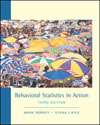Mark W. Vernoy,
Palomar College
Diana J. Kyle,
Fullerton College
| Dependent variable | is the behavior exhibited by participants in an experiment that is measured and collected for statistical analysis. Changes in participants' behavior depend on the influence of the independent variable.
|
 |
 |
 |
| Estimates | are statistics collected from samples and used to describe population values.
|
 |
 |
 |
| Extraneous variable | is any variable that can vary along with the independent variable. Researchers must hold it constant (keep it from varying) because otherwise they won't know whether it was the independent variable(s) or extraneous variables that caused or didn't cause changes or differences in the dependent variable.
|
 |
 |
 |
| Independent variable | is the factor in an experiment that is selected, manipulated, and/or controlled by the experimenter and is intended to be the cause of changes or differences (if any) in the dependent variable.
|
 |
 |
 |
| Interval scale of measurement | is a quantitative scale used to measure the dependent variable. Data indicate relative ranks and the degrees of difference between scores, but the zero point on this scale is not meaningful.
|
 |
 |
 |
| Nominal scale of measurement | is the simplest form of measurement. It is used when the dependent variable is qualitative and categorizes data based on the name of some physical or psychological quality or characteristic rather than a numerical score.
|
 |
 |
 |
| Null hypothesis | is one of the two, mutually exclusive hypotheses that predict there will be no relationship or change in behavior(s) among the group(s) being measured.
|
 |
 |
 |
| Ordinal scale of measurement | is the simplest quantitative scale used to measure the dependent variable. Data are ranked in some order such as, highest to lowest, biggest to smallest, most important to least important, etc., but does not measure the extent or how much difference there is between measures.
|
 |
 |
 |
| Parameters | are statistics that describe population values.
|
 |
 |
 |
| Population | is all the members of a specified group. Its size can be very small, extremely large, or may not be known depending on how the particular group of interest is defined.
|
 |
 |
 |
| Ratio scale of measurement | is the quantitative scale that has all the properties of nominal, ordinal, interval data and a meaningful zero point on the scale. Zero on this scale means the absence of something and makes ratio comparisons possible.
|
 |
 |
 |
| Research hypothesis | is one of the two mutually exclusive hypotheses that predict there will be a relationship or change in the behavior(s) measured.
|
 |
 |
 |
| Sample | is a small and relatively representative group that was selected from a population.
|
 |
 |
 |
| scientific hypothesis | is stated in the form of a prediction and is a possible explanation for the behavior that will be studied. It is based on gathered facts and theories from previous studies. It must be testable and stated in such a way that it can be falsified.
|
 |
 |
 |
| Statistics | is a branch of applied mathematics using numbers to describe and analyze data collected by research scientists.
|
 |
 |
 |
| Variables | are events or qualities that can assume more than one value, such as gender that has the value of male and the value of female.
|



 2002 McGraw-Hill Higher Education
2002 McGraw-Hill Higher Education